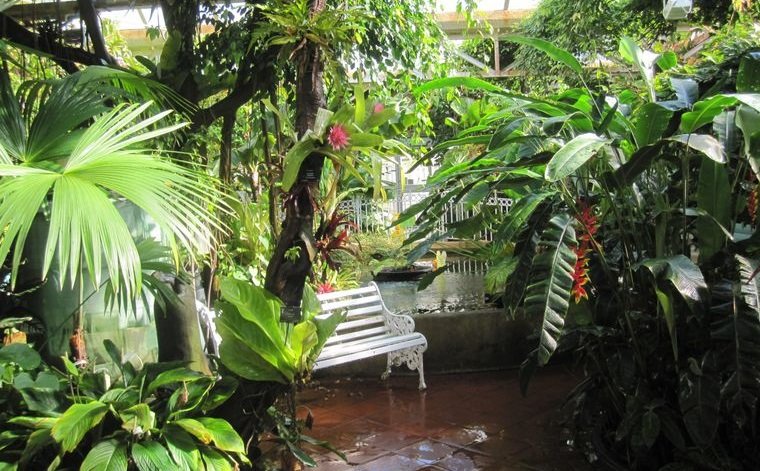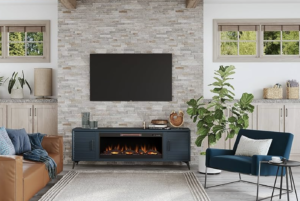
A tropical garden certainly has an exotic look due to the combination of colors and contrasts with amazing foliage. Some gardens can look a bit uneven and dull, especially at the end of July. This is because many plants begin to fade. So one way to inject life into this outdoor space is to turn it into a tropical garden. Most people start to see the results of tropical garden ideas in late summer and pick up speed in mid-fall. Without a doubt, acquiring plants that are ready for the garden will give the space an exotic atmosphere during the rest of the summer. Plus, it’s an easy way to enhance color and give your garden ideas a spike of interest that will last until the first frosts.
How to Design a Tropical Garden
Tropical is undoubtedly always associated with vacations. So having a tropical garden is a great way to admire your space and relax. Of course you will need a rich mix of foliage textures and colors for an exotic and peaceful garden setting. Think big, vibrant foliage, quirky blooms, and eye-catching statement plants. Group plants with various leaf shapes and use variegated foliage. It should be mentioned that this style of gardens is not unique to the tropics, as it is also ideal for frost-free gardens and can provide shelter for plants from the afternoon sun.

But before we get started with the plants and their locations, it is important that you know some of the key components for a tropical garden. These types of gardens evoke a great sense of relaxation. Even the images of tropical places are enough to calm the soul. You don’t need a huge garden to create a stunning tropical look. Keep in mind that large leaves have a greater impact on gardens. You can even use walls, fences, and other surfaces to create a tropical vertical garden. For this, a vertical garden of vibrant climbers that have an exotic air, are as perfect as trumpet and star jasmine vines.

Elements of a tropical garden
As we already mentioned, this design style can certainly be adapted to any climate. Plants do not technically have to be tropical in nature, they should only contribute to the overall appearance and character of a tropical garden. But regardless of where you live, these are the building blocks for creating the tropical garden of your dreams. Large, lush and luxurious foliage is usually the main focus in tropical gardens. The plants flaunt virtually every shade of green with a striking contrast in textures between large-leaved plants, those with long, thin fronds, and the lacy look of ferns.

Surround the plant space, consider planting in abundance at different levels or heights, from towering trees to ground cover. Hanging baskets and raised beds are perfect for creating the illusion of an enveloping cocoon of plant life. You want to make sure you keep your garden vibrant. Tropical gardens would not be complete without the warm colors of the flowers, reminiscent of the exotic birds that inhabit the rainforests. Bright shades of yellow, orange, red, and pink are great for accentuating these types of gardens.

You should keep in mind that a large number of large-leaved plants also involves a large amount of water. So a water feature is ideal for creating an exotic display. The sight, sound and smell of flowing water really enhance the feeling of being in a tropical place. Remember that this style of garden is inspired by the tropical jungle, so humidity plays a very important role in the overall aesthetic. That is why incorporating an animated water feature is always recommended. The way the water shines in the sunlight is undoubtedly magical, especially when listening to that relaxing sound in an outdoor space.

Prepare the soil and place tropical foliage
Gardening in tropical and subtropical areas, of course, requires a different approach than gardening in a temperate climate. Tropical gardeners very rarely have to dig for planting. They usually only put compost, leaf mold, yard clippings, and mulch on the ground. The formation of layers of leaf mulch is a process that occurs naturally in forests and ravines, where soil fertility resides only in the first few centimeters.

As we indicated, one of the main elements of a tropical garden is the foliage. For the most part, tropical gardens rely on foliage rather than flowers to generate year-round interest. The foliage should be flamboyant, lively and colorful, and the plants should be chosen based on the size, shape and texture of their leaves. Planting in groups of odd numbers is a very common trick employed by garden designers. This gives a wide brushstroke of color and texture, and makes a big difference to the feel of the garden.

Placing plants with contrasting foliage side by side will create drama and visual interest. Even if you want to maximize impact, place plants with red, yellow, orange, pink, purple, and lime green leaves side by side. Colorful blooms like fragrant frangipani, heavenly hibiscus, ornamental ginger, and dramatic canna lilies will warm up the garden and provide a greater contrast to the vibrant ground-dwelling foliage and green canopy.

The best plants for a tropical garden
Plants such as plumeria, alstroemeria or Peruvian lilies, calla lilies, canna lilies, agapanthus or lilies of the nile, colocasia or elephant ear, pineapple and caladium lilies, are great to infuse all the richness and wonder of the tropical rainforest. These plants that we name you, can successfully overwinter indoors and then take them outdoors in spring through fall, this especially for places with cold climates. There are a number of plants that produce lush foliage in different shapes, sizes, and colors.

If you want to garden in a cooler climate, you may want to consider other hardy plants that can add tropical beauty to your garden with bold colors and beautiful foliage. Hostas are colorful plants with extremely cold tolerant foliage and are a perfect addition to tropical gardens in colder climates. Lily of the valley, also exceptionally cold hardy, produces wide, lush leaves perfect for the look of a tropical garden.

Japanese and Siberian irises create a cold-hardy source of narrow leaves topped by colorful flowers that are reminiscent of butterflies with these beauties. Daylilies are charming cold-tolerant plants, have foliage somewhat similar to palm leaves and fit perfectly in a tropical space. In addition to those already mentioned, you can also consider Hawaiian hibiscus, rhododendron vireya, crab claw, fiji fire plant.

Giant Elephant Ears, Elephant Ears (Alocasia amazonica), Prayer Plant, Zebra Plant, Abyssinian Banana, Croutons, Dancing Ladies. Canna lilies, sago palm, spiral ginger, crinum lily, Bali sacred bamboo, variegated shell ginger, spindle palm, majestic palm, and medinilla. Bright-leaved bromeliads will surprise you with their toughness and vigor. They bloom only once, but will continue to grow, sprouting new plants or suckers from their side. When a sapling reaches about 10 centimeters, cut it off with a sharp knife and replant it in pine bark, not soil.

In the same way, you can let the tropical plant adhere naturally. Bromeliads don’t have to be planted in the garden, they are just as happy clinging to tree trunks or in pots. Also, most ornamental gingers die in winter, so remove all dying, hairy foliage. When the weather warms up, feed them aged manure as soon as the new foliage appears. You should also keep in mind that gingers need regular watering during their growing season.

Tropical trees and edible plants for your tropical garden
A selection of perfectly placed palm trees and bamboo is essential to achieve a tropical look in your garden or backyard. Although they are generally criticized for growing large, palms and bamboo will benefit the style and mood of the garden. They provide an amazing and pleasant rustle of foliage blowing in the wind, furnish your garden with a fern-like roof, and can create some privacy as they can create green walls. There are many options to choose from, so it is best to attend a specialized palm or bamboo nursery where you can seek expert advice.

Remember that not all varieties are adapted to all climates, but dwarf or smaller-growing specimens are the best option for gardens and backyards. If you love to cook, you can even try growing Asian herbs and spices in your tropical garden. Not only do they add wonderful flavors and aromas to a wide variety of dishes, but they also smell and flavor the garden helping to deter pests. Cardamom, kaffir lime, lemongrass, coriander, and mint will grow well among tropical shrubs in cool, humid locations. Edible ginger planted in spring will be ready to harvest in March or April.

How to Maintain a Tropical Garden
Of course you shouldn’t expect a tropical garden to be maintenance-free. In the tropics, the best time to garden is early in the morning, before the heat and humidity builds. Well, take a walk in your garden every morning, weather permitting, and prune as you go. All pruning material should preferably be shredded and then composted in order to return it to the garden to maintain the natural cycle. Keep in mind that when gardening in hot, rainy weather, plants will explode out of the ground during wet spells.

So they should be pruned. The need for constant cleaning means that a good pair of pruning shears is essential. Use them to regularly tidy up any brown foliage, dead palm leaves, and spent flowers. You should feed your garden with a compost mulch each spring and spray all the foliage with an algae solution once each season to keep the plants sturdy and strong. In tropical gardens, it is best to keep a small area for your lawn, as you will waste a lot of time cutting and weeding.

As for the location, it is best to group tropical plants and place them in a place protected from strong winds, which can cause large leaves to break. This is a big problem especially with banana plants. In addition, grouping them will also create a microclimate, increasing humidity levels. It is worth mentioning that many of these tropical plants prefer indirect light so that the leaves and flowers do not burn. You can also consider grouping tropical plants with brightly colored native and Mediterranean plants to keep the look. Pelargonium and agapanthus roses work well.

Certainly, gardening has many benefits for general health. The time we spend in the garden has a clear and positive impact on us, both physically, mentally and emotionally. Some studies suggest that the act of planting and caring for plants improves concentration and reduces stress levels among other benefits. So do not limit yourself if you have a small garden, if you want to have a tropical space you have many ways to achieve it and benefit from nature.

Without a doubt, a tropical garden makes us think of vacations

No matter how small the space is, you can still have a small and relaxing tropical garden

Keeping an eye out for plants gives you general health benefits

Consider a lush backyard with beautiful foliage

Bring your outdoor space to life by setting up a tropical garden

Palm trees and plants with big leaves, sometimes it’s all you need

Infographic Provided by American Residential Services




